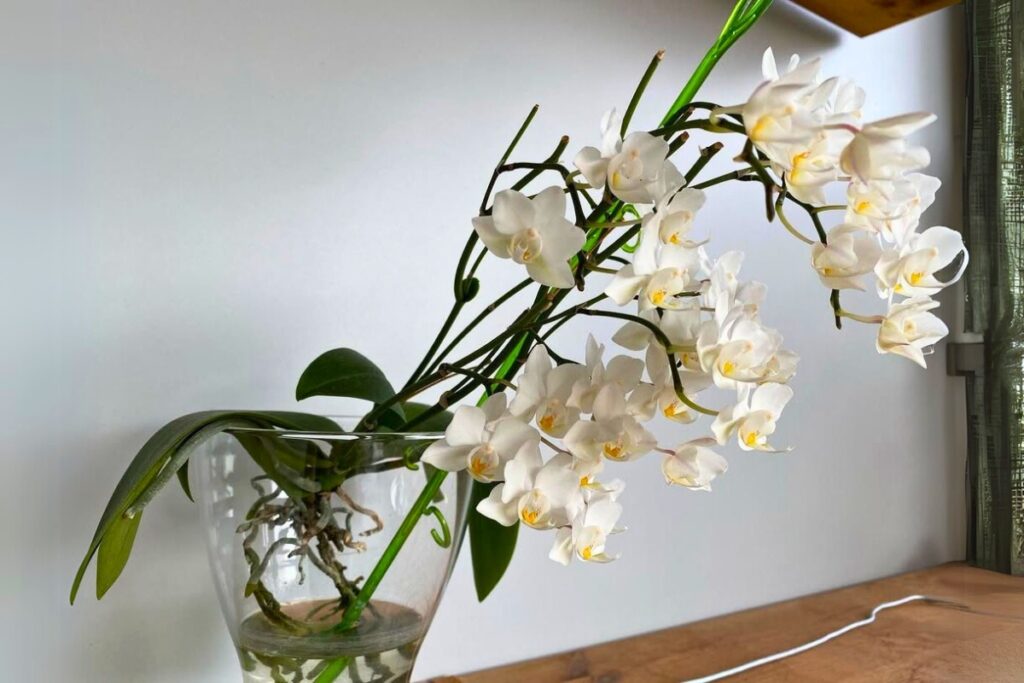If you’ve ever struggled with traditional potting media for orchids, you’ll be intrigued by water culture, a soil-free growing method that’s gaining popularity among both novice and experienced growers. You can actually grow these elegant plants in nothing but water and a clear container, which lets you monitor root health with unprecedented clarity. While it might seem counterintuitive to grow orchids this way, the technique offers several advantages that could revolutionize your approach to orchid care.

Contents
Understanding Water Culture Methods for Orchids
While traditional orchid growing relies on bark or moss media, water culture methods offer a soil-free alternative that’s gaining popularity among indoor gardeners. You’ll find two main approaches: full water culture and semi-water culture.
In full water culture, you’ll place your orchid’s roots directly in water, ensuring the crown stays above the waterline. The water level should reach about 1-2 inches up the roots, and you’ll need to change it every 5-7 days.
Semi-water culture involves alternating between wet and dry periods. You’ll submerge the roots for 2-3 days, then let them dry for 4-5 days, mimicking natural rainfall patterns.
Essential Equipment and Setup Requirements
Setting up a water culture system for orchids requires specific tools and equipment to create the right growing environment. You’ll need clear glass containers (4-6 inches deep), net pots or orchid baskets, and support clips to keep plants stable. Don’t forget a TDS meter to monitor nutrient levels.
Temperature control is essential, so invest in a reliable thermometer and consider a small fan for air circulation. You’ll also want water-soluble orchid fertilizer, hydrogen peroxide (3% solution), and pH testing strips to maintain ideal conditions.
For maintenance, keep pruning scissors, cotton swabs, and spare glass containers nearby for water changes and plant care routines.
Best Orchid Species for Water Culture
Three particular orchid species thrive exceptionally well in water culture systems: Phalaenopsis, Vanda, and Paphiopedilum. You’ll find Phalaenopsis (moth orchids) adapt quickly to water culture, with their thick, fleshy roots readily absorbing nutrients from the solution.
Vandas are natural choices for hydroponics since they’re air-root orchids in their native habitat. Their long, sturdy roots dangle freely in the water, making them perfect candidates for hanging arrangements.
Paphiopedilums (slipper orchids) do well when you maintain water levels at 1-inch depth. Their compact root system means they won’t outgrow smaller containers, and they’ll reward you with unique, long-lasting blooms.
Step-by-Step Transition to Water Growing
Moving your orchids from soil to water requires careful planning and timing to minimize stress on the plants. You’ll want to begin the shift when your orchid isn’t flowering, ideally during its active growth phase in spring or early summer.
Start by gently removing all potting media from the roots, rinsing them thoroughly with lukewarm water. Trim any rotted roots (they’ll be black or mushy) with sterilized scissors. Let the roots air-dry for 2-3 hours.
Place your orchid in a clear container, ensuring the roots rest in 1-2 inches of water while keeping the crown above water level. Change the water every 5-7 days.
Maintaining Healthy Water-Grown Orchids
While maintaining water-grown orchids isn’t complicated, you’ll need to establish a consistent care routine to keep your plants thriving. Change the water every 7-10 days, using room temperature filtered or distilled water to prevent mineral buildup.
Monitor your orchid’s root system weekly for any signs of rot or algae growth. Trim damaged roots with sterilized scissors, and clean the container monthly with a mild hydrogen peroxide solution.
Maintain temperatures between 65-80°F (18-27°C), and guarantee indirect light exposure for 12-14 hours daily. Don’t forget to fertilize every third water change with a quarter-strength orchid fertilizer specifically formulated for hydroponic growing.
